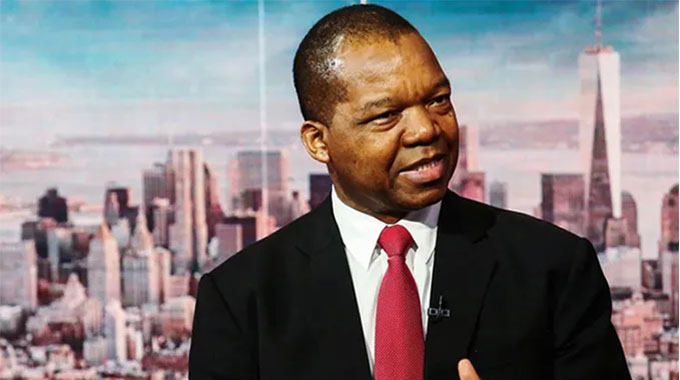Informal sector market rate won’t trigger inflation: Mangudya

Golden Sibanda, Harare Bureau
THE Reserve Bank of Zimbabwe (RBZ) says the parallel market exchange rate will not upset the current momentum of falling inflation as informal sector transactions account for only a small fraction of total payments.
Zimbabwe’s annual inflation rate hits a record low since 2019 this month, falling to 56,37 percent from 106,6 percent in June. The RBZ projects inflation to plunge further to between 20 and 30 percent by December. The massive fall in the annual rate of inflation has been celebrated across the economy, after the hyper-inflationary era up to 2008, when inflation topped 500 billion, according to the International Monetary Fund.
Zimbabwe had seen sustained increase in inflation on account of (formal) depreciation of its local currency, which has lost ground against the green back, from $2,5/US$1 in February 2019 to the current $85/US$1. But the inflation spiral was immediately halted once the central bank introduced the Dutch Auction System for trading foreign currency in June last year, which successfully stabilised the Zimbabwe dollar exchange rate.
RBZ Governor Dr John Mangudya said in an interview that the direction of the exchange rate will, going forward, be influenced by key economic fundamentals, both internal and exogenous.
“Go to Mbare Musika (Market) today and buy say bananas, what (exchange) rate are they using, $110-$120/US$1, so they (informal sector) are not the ones driving the parallel market rate increases,” Dr Mangudya said.
The Zimbabwe dollar, while largely steady at $85 to the US dollar on the Reserve Bank weekly auction, has hit between $135 and US$145/US$1 on the black market, which some observers believe reflects growing liquidity. However, in 2021, the RBZ lowered reserve money growth target per quarter from 25 percent in 2020 to 22.5 percent, in order to send a strong signal to the market that the Government will do whatever it takes to stabilise the rate.
“They depend on the formal sector. What do they sell in the informal sector, cooking oil, sugar, milk? Have you ever seen the informal sector producing goods? They (informal sector) mostly sell finished products.
“Those people do not use rates that are ridiculous as is the case with the formal sector, they are very few. The problem is from oligopolies and monopolies, that is why we came up with SI 127, to deal with outliers.
“All my hands are on the deck for stability and recovery of the economy, and I am very focused on that. This is time for celebration; (annual) inflation went down from 837,5 percent in July last year to 56 percent in a year’s time.
“It is a record that has not happened anywhere. So, we need to continue (on the current trajectory) and as the central bank governor, the question is ‘How do we anchor inflation expectations?’” Dr Mangudya said.
The RBZ projects inflation to close the year between 20 and 30 percent on account of fiscal sustainability, international commodity price boom, growth in exports and conservative monetary targeting and the bumper harvest.
“Most of the transactions are happening in the formal sector. So why should we worry about 5 percent in the informal sector, as if it’s greater than 95 (percent), as RBZ governor I do not dwell on that” Dr Mangudya said.
Economists estimate that more than 60 percent of Zimbabwe’s economy is now accounted for by informal sector players, following the economic downturn that characterised the Southern African country for the past two decades.
While the foreign exchange auction system has provided relief as a source of foreign currency for registered businesses, it uses a priority list allocation framework, meaning not everybody gets the scarce hard currency. This forces a number of economic agents, including the majority of informal sector players, who cannot access foreign currency on the RBZ auction system to use the black market to procure the forex they require.
Inevitably, the high cost of purchasing the foreign currency on the parallel market eventually gets passed on and fused into the final price of the product or service, which is then sold to the unsuspecting consumer. Captains of industry are on record saying given the now sophisticated form of the informal sector in Zimbabwe; formal businesses also bear the cost of exorbitant parallel market rates, as some use informal suppliers.
Notably though, the auction system, which has distributed over US$1,5 billion to key sectors of the economy for imports, has been credited with helping to stabilise the exchange rate, hence inflation decline.
The central bank chief said the inflation rate will, going forward, take cue from fundamentals, which if right, will anchor inflation decline. These include the external sector (exports), Diaspora remittances (capital account), real sector (productive industry).
Dr Mangudya said average capacity utilisation in the domestic industry was increasing, driven by improved access to foreign currency while the good agricultural season, while saving millions of forex on imports, will anchor low food inflation.
“That saving of foreign currency will see the resources going to the real sector, therefore we will continue expanding production, therefore the future looks brighter,” the RBZ Governor said.
He said global economic power houses like China and the United States were pouring billions in domestic stimulus packages, which has driven up commodity prices, to the delight of exporters like Zimbabwe.
“As a commodity exporter, when prices increase, it means our external sector will continue to be strong. If the IMF releases the US$650 billion (Special Drawing Rights equivalent), there will be more money in the global economy,” he said.











Comments